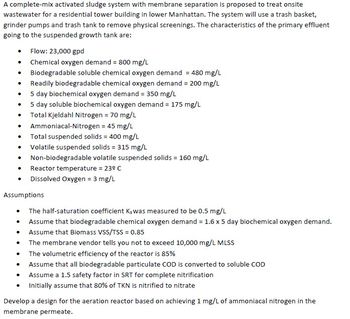
Biochemistry
9th Edition
ISBN: 9781319114671
Author: Lubert Stryer, Jeremy M. Berg, John L. Tymoczko, Gregory J. Gatto Jr.
Publisher: W. H. Freeman
expand_more
expand_more
format_list_bulleted
Question
what is the influent biodegradable chemical oxygen demand?

Transcribed Image Text:A complete-mix activated sludge system with membrane separation is proposed to treat onsite
wastewater for a residential tower building in lower Manhattan. The system will use a trash basket,
grinder pumps and trash tank to remove physical screenings. The characteristics of the primary effluent
going to the suspended growth tank are:
.
.
•
●
•
•
•
Flow: 23,000 gpd
Chemical oxygen demand = 800 mg/L
Biodegradable soluble chemical oxygen demand = 480 mg/L
Readily biodegradable chemical oxygen demand = 200 mg/L
5 day biochemical oxygen demand = 350 mg/L
5 day soluble biochemical oxygen demand = 175 mg/L
Total Kjeldahl Nitrogen = 70 mg/L
Ammoniacal-Nitrogen = 45 mg/L
Total suspended solids = 400 mg/L
Volatile suspended solids = 315 mg/L
Non-biodegradable volatile suspended solids = 160 mg/L
Reactor temperature = 23º C
• Dissolved Oxygen = 3 mg/L
Assumptions
The half-saturation coefficient Ks was measured to be 0.5 mg/L
Assume that biodegradable chemical oxygen demand = 1.6 x 5 day biochemical oxygen demand.
Assume that Biomass VSS/TSS = 0.85
The membrane vendor tells you not to exceed 10,000 mg/L MLSS
The volumetric efficiency of the reactor is 85%
Assume that all biodegradable particulate COD is converted to soluble COD
Assume a 1.5 safety factor in SRT for complete nitrification
Initially assume that 80% of TKN is nitrified to nitrate
Develop a design for the aeration reactor based on achieving 1 mg/L of ammoniacal nitrogen in the
membrane permeate.
Expert Solution
This question has been solved!
Explore an expertly crafted, step-by-step solution for a thorough understanding of key concepts.
This is a popular solution
Trending nowThis is a popular solution!
Step by stepSolved in 2 steps

Knowledge Booster
Similar questions
- What are the consequences of using water from ponds and rivers to cool industrial processes? What are the consequences of stopping the thermal pollution (forcing an industry to stop releasing the heated water)?arrow_forwardWhat will happen to the mineral nutrients released to the soil by the decomposers?arrow_forwardThe term BOD (Biological Oxygen Demand): Group of answer choices is a measure of the organic matter and other oxygen-demanding wastes in a)a lake or stream. b)is the highest after a person eats a candy bar c)is defined as the amount of oxygen needed by fish to survive. d)is defined as the number of organisms that need oxygen in a stream. Nextarrow_forward
- What is the major Anthropgenic flux in the global Sulfur cycle?arrow_forwardWhy is the stringent response typically active during nitrogen starvation but not in response to carbon sources?arrow_forwardIn terms of the nitrogen cycle and movement of electrons, what is the difference between nitrogen fixation and assimilatory nitrate reductionarrow_forward
- Differentiate between transpiration and evaporation.arrow_forwardWhich fraction of phosphorus is available for photosynthetic organisms to directly uptake and use? Organic phosphorus in detritus Absorbed phosphorus in clay Phosphorus in minerals in rocks Soluble phosphorus in waterarrow_forwardHow is carbon dioxide madeby producers and consumers?arrow_forward
arrow_back_ios
SEE MORE QUESTIONS
arrow_forward_ios
Recommended textbooks for you
 BiochemistryBiochemistryISBN:9781319114671Author:Lubert Stryer, Jeremy M. Berg, John L. Tymoczko, Gregory J. Gatto Jr.Publisher:W. H. Freeman
BiochemistryBiochemistryISBN:9781319114671Author:Lubert Stryer, Jeremy M. Berg, John L. Tymoczko, Gregory J. Gatto Jr.Publisher:W. H. Freeman Lehninger Principles of BiochemistryBiochemistryISBN:9781464126116Author:David L. Nelson, Michael M. CoxPublisher:W. H. Freeman
Lehninger Principles of BiochemistryBiochemistryISBN:9781464126116Author:David L. Nelson, Michael M. CoxPublisher:W. H. Freeman Fundamentals of Biochemistry: Life at the Molecul...BiochemistryISBN:9781118918401Author:Donald Voet, Judith G. Voet, Charlotte W. PrattPublisher:WILEY
Fundamentals of Biochemistry: Life at the Molecul...BiochemistryISBN:9781118918401Author:Donald Voet, Judith G. Voet, Charlotte W. PrattPublisher:WILEY BiochemistryBiochemistryISBN:9781305961135Author:Mary K. Campbell, Shawn O. Farrell, Owen M. McDougalPublisher:Cengage Learning
BiochemistryBiochemistryISBN:9781305961135Author:Mary K. Campbell, Shawn O. Farrell, Owen M. McDougalPublisher:Cengage Learning BiochemistryBiochemistryISBN:9781305577206Author:Reginald H. Garrett, Charles M. GrishamPublisher:Cengage Learning
BiochemistryBiochemistryISBN:9781305577206Author:Reginald H. Garrett, Charles M. GrishamPublisher:Cengage Learning Fundamentals of General, Organic, and Biological ...BiochemistryISBN:9780134015187Author:John E. McMurry, David S. Ballantine, Carl A. Hoeger, Virginia E. PetersonPublisher:PEARSON
Fundamentals of General, Organic, and Biological ...BiochemistryISBN:9780134015187Author:John E. McMurry, David S. Ballantine, Carl A. Hoeger, Virginia E. PetersonPublisher:PEARSON

Biochemistry
Biochemistry
ISBN:9781319114671
Author:Lubert Stryer, Jeremy M. Berg, John L. Tymoczko, Gregory J. Gatto Jr.
Publisher:W. H. Freeman

Lehninger Principles of Biochemistry
Biochemistry
ISBN:9781464126116
Author:David L. Nelson, Michael M. Cox
Publisher:W. H. Freeman

Fundamentals of Biochemistry: Life at the Molecul...
Biochemistry
ISBN:9781118918401
Author:Donald Voet, Judith G. Voet, Charlotte W. Pratt
Publisher:WILEY

Biochemistry
Biochemistry
ISBN:9781305961135
Author:Mary K. Campbell, Shawn O. Farrell, Owen M. McDougal
Publisher:Cengage Learning

Biochemistry
Biochemistry
ISBN:9781305577206
Author:Reginald H. Garrett, Charles M. Grisham
Publisher:Cengage Learning

Fundamentals of General, Organic, and Biological ...
Biochemistry
ISBN:9780134015187
Author:John E. McMurry, David S. Ballantine, Carl A. Hoeger, Virginia E. Peterson
Publisher:PEARSON